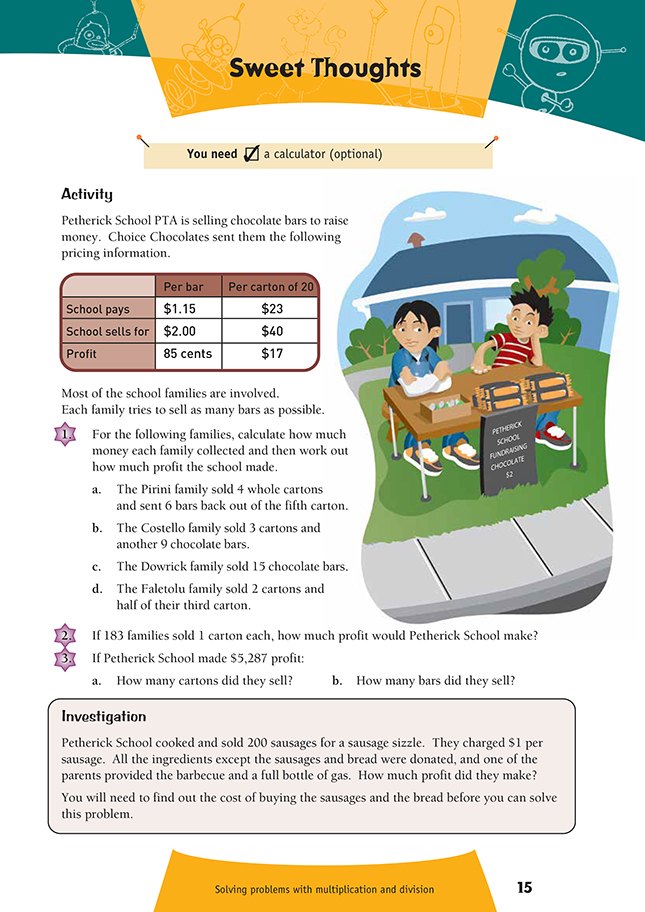This is a level 4 number activity from the Figure It Out series. It relates to Stage 7 of the Number Framework.
A PDF of the student activity is available.
Click on the image to enlarge it. Click again to close. Download PDF (220 KB)
solve money problems using multiplication and division
FIO, Level 3, Number, Book 2, Sweet Thoughts, page 15
A calculator (optional)
The quantities involved in this activity are challenging because they require the students to use the distributive property as they split numbers. You will have to decide to what extent you wish the students to use a calculator.
You may decide to use some of the questions to help the students develop their advanced multiplicative strategies, in which case, they should solve the problems without a calculator. (Some strategies are shown in the Answers.) They could use the calculator to check their work once they have a solution.
Alternatively, you may decide, for some of the questions, that you want the students to form a suitable equation by interpreting the problems. In this case, they could estimate the answers and then solve them on a calculator.
You can encourage both learning intentions by having the students do some of question 1 without a calculator and then allow them to use a calculator for the rest.
Estimation is an important skill that links clearly to the use of the calculator as a tool. The students must be able to estimate the answer so that they know if they have pushed the right buttons on the calculator. Estimation skills require quick recall of all basic facts, number sense, knowledge of place value, and multiplying and dividing by 10, 100, and so on.
Note that there is a mix of units in question 1. The profit on cartons is in dollars, while that of single bars is in cents. Some students may have problems with this.
For question 3a, most students will need to have access to a calculator because the question requires long division by a divisor that is a 2-digit prime number. Without the use of a calculator, it is beyond level 3 of the curriculum.
Investigation
Have the students explore two or three sources of bread and sausages to get the best profit. They also need to note the number of slices in particular loaves of bread. There may be a significant difference between the toast-sliced and the sandwich-sliced loaves. They may wish to discuss the provision of whole grain versus white bread in terms of cost and as a health issue.
Answers to Activity
1. a. Collected $188 ($160 + $28); profit $79.90 ($17 x 4 + 85c x 14)
b. Collected $138 ($120 + $18); profit $58.65 ($17 x 3 + 85c x 9)
c. Collected $30 (15 x $2); profit $12.75 (85c x 15)
d. Collected $100 ($40 x 2 + $20); profit $42.50 ($17 x 2 + $8.50)
2. $3,111. ($17 x 183)
One way to work this out is:
183 x 10 = 1 830
1 830 + 1 830 – (183 x 3)
= 3 660 – (300 + 240 + 9)
= 3 660 – 549
= 3 111
3. a. 311 cartons. (5 287 ÷ 17)
b. 6 220 bars. (5 287 ÷ 0.85 or 311 x 20)
Investigation
Answers will vary.
